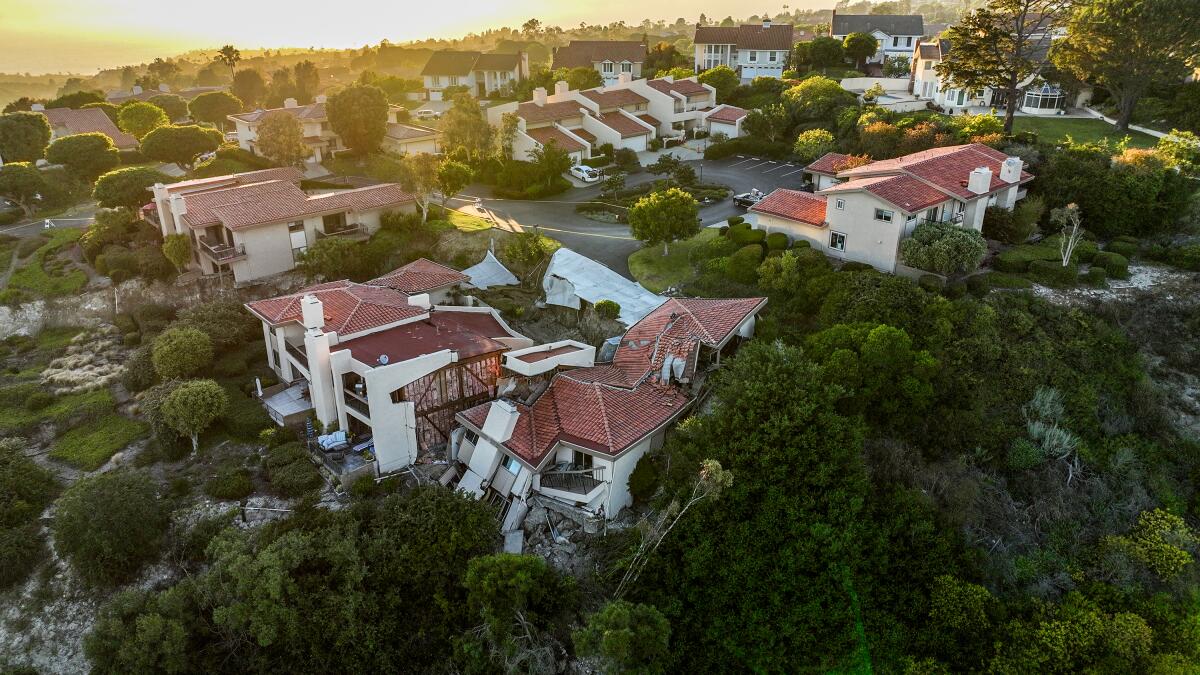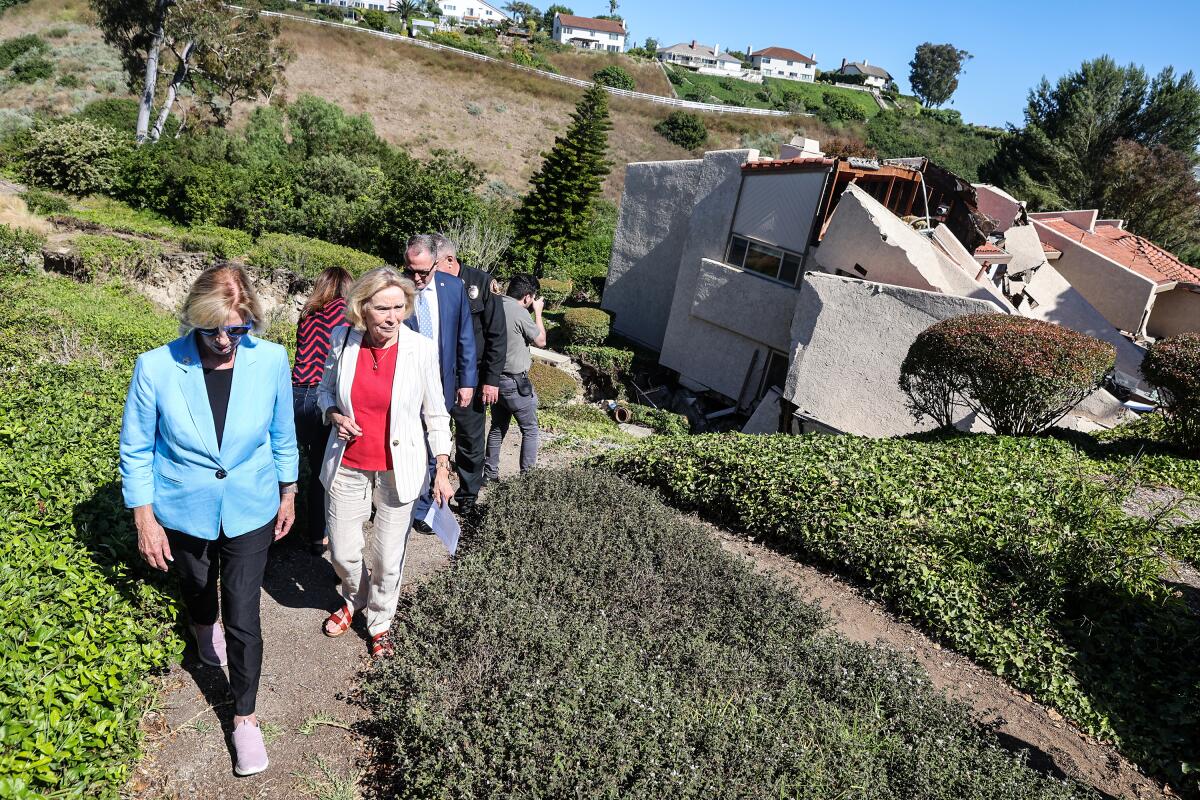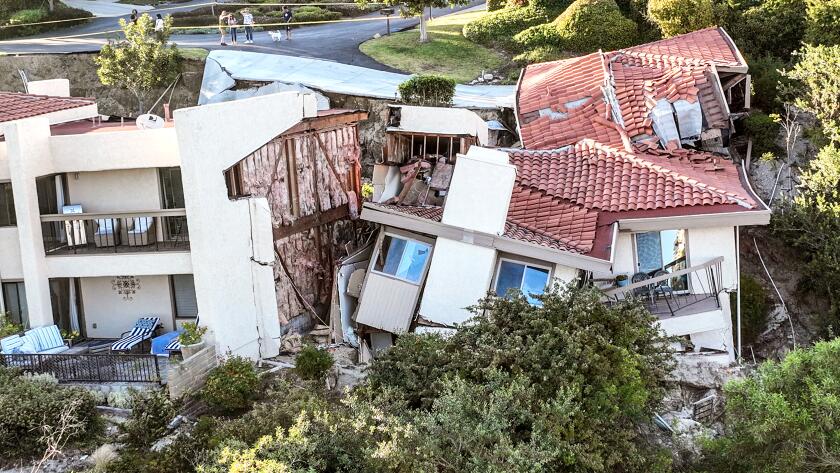Rolling Hills Estates declares emergency, wants answers after devastating landslide
- Share via
Multiple homes in a Rolling Hills Estates neighborhood had slid down the hillside by Tuesday as a major landslide continued to push them into a canyon.
- Share via
The Rolling Hills Estates City Council declared a local state of emergency Tuesday in the wake of a landslide that sent multiple hillside houses on a slow-motion downward slide, collapsing roofs and cracking walls along the way.
The action, which passed unanimously, allows the city to ask for financial support from the state Office of Emergency Services and the Federal Emergency Management Agency. Jessica Slawson, a management analyst from the city manager’s office, said adoption was key to fund assistance programs for residents.
Part of the aid offered by the city, according to Mayor Britt Huff, has been offering “assistance to find shelter” for those displaced.
“We are here to offer support and sympathy for our fellow Peartree Lane residents who have been displaced from their homes by the land movement,” Huff said.
Twelve units on the street were evacuated and deemed unsafe for reentry on Saturday following the landslide, which remains, so far, unexplained. As of Tuesday, some houses had dipped below what remained of their driveways, nearly hidden from the road they previously lined.
Five additional homes were evacuated on Tuesday as continued ground movement caused a sewer main to break.
Rolling Hills Estates officials, in a statement late Tuesday, said the earth’s movement along the affected street had slowed as of 4 p.m.
It wasn’t immediately clear when the sewer main broke, and the location of the five newly evacuated units wasn’t made public.

“Newly evacuated residents are being provided with assistance to find shelter and the city has been in direct contact with them all,” the city’s statement said. Sixteen residents were displaced in the initial evacuation. It wasn’t immediately clear how many people were evacuated from the five additional units.
Huff, the mayor, told The Times after Tuesday evening’s City Council meeting that she was growing “anxious” about the hiring process for a geologist.
“Everybody wants to know what happened,” Huff said.
The Rolling Hills Park Villas Homeowners Assn. was tasked with hiring a geologist to examine the root cause of the devastating canyon collapse.
Huff said an association management team was in the process of “recruiting and hiring” such a specialist. She said, however, that she knew little about the process and hoped for transparency.
On Monday night, city staff met at City Hall with residents who had been evacuated, according to the mayor. Huff was informed that, directly afterward, a virtual HOA meeting was held, to her chagrin.
“We would have liked to have seen them [hold the meeting] in person,” said Huff, adding that virtual gatherings make it “hard sometimes to hold somebody accountable.”
She added that the City Council was going to “throw city influence” to speed up the hire.
“It’s made everybody on the peninsula a little anxious,” Huff said of the landslide.
Huff said she expected Supervisor Janice Hahn to push for a county state of emergency. The mayor said Hahn had been in contact with Gov. Gavin Newsom, looking for state resources and a California state of emergency.
Residents said after the disaster that they were stunned as they watched the neighborhood’s multimillion-dollar homes fall down the hillside.
“Just shock,” resident Katie Schwartz, 57, said Monday, taking in the escalating damage. “It just changes your whole life.”
Tuesday morning, David Zee sat in a lawn chair outside his standing but red-tagged home, unwilling to miss any developments that might affect his family.
“Hopefully, the experts will start rolling through,” said Zee, 52. “I just want to make sure that I’m getting the most up-to-date information.”
Since Monday evening, he has noticed some additional shifting among his neighbors’ homes, but they are not dropping as dramatically as they did the day before, he said. He still hears the occasional “Rice Krispie” popping from the homes as they shift.
“Everything’s still waiting on the geologists,” Zee said.
Worried homeowners want to know what a geologist will say about the conditions, said Paul Ginsburg, who has lived in the neighborhood across from Peartree Lane for 23 years. Though his home is unaffected, he said, friends and acquaintances had been reaching out since Saturday.
“Even my plumber asked, ‘Are you OK?’” said Ginsburg, 76.
Ginsburg’s friend who lived in one of the red-tagged homes died while vacationing in Italy around a month ago. Her home was listed for sale and the open house was scheduled for Sunday — until the landslide happened.
“It’s sad,” Ginsburg said. “It sort of takes a while to sink in.”
Garage doors on some of the units have almost completely flattened, driveways dramatically drop off, and massive crevices expose beams and pipes.

“They’re absolutely collapsing on top of themselves, the roofs are at ground level,” Los Angeles County Supervisor Janice Hahn said Monday. “The force of gravity is taking them. … These homeowners have lost their homes and, really, the land that the home sits on is also gone.”
Hahn first visited the street late Saturday and said she could hear the “snap, crackle, pop” of shifting homes, but the movement seemed minor. By Sunday, the homes had fallen six to 10 feet down the ravine. Monday’s damage was “astonishing,” she said.
“There’s nothing we can do, I’ve been told, to stop what’s happening,” Hahn said. “That’s why it’s wait-and-see at that point. Waiting for the homes to fall.”
Homes in Rolling Hills Estates continued to move Monday morning, more than a day after 12 houses were evacuated because of a major ground shift.
As sunshine bathed the neighborhood Tuesday morning, TV news crews angled to get a better look at a dozen Southern California Gas Co. workers digging into a hillside near Peartree Lane, which L.A. County sheriff’s deputies had closed off.
The workers said they were routing gas back to a housing complex that had not been red-tagged but had had its gas shut off Saturday night along with the sunken homes, which shared the gas line.
Firefighters will remain on site until the shifting ceases, Los Angeles County Fire Chief Anthony Marrone said.
“We don’t know how long these homes are going to continue to move,” he said. Officials are “waiting to see what the determination is going to be.”
A member of the Rolling Hills Park Villas homeowners association’s board and its management company, Scott Management, declined to comment or take questions Tuesday. The HOA is responsible for hiring a geologist to assess the land, officials have said. It’s still unclear when that will happen or who that will be.
Some residents said they had received updates from HOA officials who told them everything was stalled while the ground was moving.
It’s still unclear what caused the landslide in the community, which is on the southwestern side of the Palos Verdes Peninsula.
Still, the landslide is not entirely surprising to geologists who understand the makeup of the land in the Palos Verdes Peninsula and the history of the region.
Coastal land in Southern California is typically underlain by somewhat soft marine sediments and dirt, said Colin Robins, associate professor of environmental science at Claremont McKenna College.
The land in and around Rolling Hills Estates is made up of shallow marine sediments, soft siliceous sedimentary mudstone and shale, according to data from the U.S. Geological Survey.
Many of those materials are easily deformable, Robins said, and when weight is added, or if any kind of pressure is released, they can move around.
Huff, the Rolling Hills Estates mayor, said city officials were surprised by the destruction wrought by the land movement.
“This neighborhood was built in 1978, and it’s been solid for 45 years,” Huff said. “So we’re very much in shock by what is happening here.”
But the fact that the area had not seen any land movement in four decades means little in the grand scope of geologic time, and the forces and probabilities involved in geologic events, Robins said.
“Our lives are relatively short,” he said. “We don’t understand that something in a hazard area can very easily sit there for years and appear fine by all outward appearances, until suddenly the stresses that have been active all along suddenly reach their breaking point.”
Landslides can be triggered by earthquakes, rain or human modifications to the land, said Associate State Geologist Jeremy Lancaster of the California Geological Survey.
Building on steep terrain, and weak rocks and soil, can lead to a landslide, but there’s a higher chance of ground movement when the land is in the footprint of a previous landslide.
There has been an increase in landslide activity across the state in the aftermath of record rainfall. Since October, the nearby Rolling Hills area of the peninsula has received nearly 23 inches of rain, according to the Department of Water and Power.
“We’ve seen a huge increase in landslide activity in many places of the state,” Lancaster said.
The Palos Verdes Peninsula has many of the characteristics for a landslide, but Lancaster spoke only hypothetically, because his agency has not responded to Peartree Lane. The state of California would need to request the California Geological Survey to assess the situation on the ground, but that has not happened.
Lancaster said the peninsula’s landscape has been shaped by previous landslides, some hundreds of thousands of years ago and some more recent.
In 1921, the Point Fermin landslide on the southeast side of the peninsula saw several homes slip off the land and into the ocean, an area now referred to as the Sunken City, Lancaster said.
Closer to Rolling Hills Estates, the Portuguese Bend slide in 1946 affected hundreds of homes. The size of the landslide was about 260 acres, and it’s still active today, Lancaster said. The land is slowly moving toward the sea.
More to Read
Sign up for Essential California
The most important California stories and recommendations in your inbox every morning.
You may occasionally receive promotional content from the Los Angeles Times.




















